|
HISTORY.
| Settled at |
Mobile Bay |
| Settled in |
1702 |
| Founded by |
Frenchmen |
| Admitted to the U. S. |
1819 |
| Population in 1860 |
964,201 |
| In 1870 |
996,992 |
| In 1880 |
1,262,505 |
| In 1890 (U. S.
Census) |
1,513,017 |
|
White |
830,796 |
|
Colored |
681,431 |
| Voting Population |
259,884 |
| Vote for Harrison
(1888) |
57,197 |
| Vote for Cleveland
(1888) |
117,320 |
| Net Public Debt |
$11,992,619 |
| Area (square miles) |
52,250 |
| U. S. Representatives (1893) |
9 |
| Militia (Disciplined) |
2,954 |
| Counties |
67 |
| Post-offices |
2,028 |
| Railroads (miles) |
3,422 |
| Manufacturers (yearly in 1880) |
$13,566,000 |
| Operatives |
10,019 |
| Yearly Wages |
$2,500,000 |
| Farm Land (in acres) |
18,855,000 |
| Farm-Land Values |
$79,000,000 |
| Farm Products
(yearly) |
$57,000,000 |
| School Children, enrolled |
259,432 |
| Newspapers |
180 |
| Latitude |
30°
13´ to 35° N |
| Longitude |
7°
51´ to 10°
38´ W |
| Temperature |
5°
to 107° |
| Mean Temperature (Mobile) |
66° |
| TEN CHIEF CITIES AND THEIR
POPULATIONS (Census of 1890) |
| Mobile |
31,076 |
| Birmingham |
26,178 |
| Montgomery |
21,883 |
| Anniston |
9,998 |
| Huntsville |
7,995 |
| Selma |
7,622 |
| Florence |
6,012 |
| Bessemer |
4,544 |
| Eufaula |
4,394 |
| Tuskaloosa |
4,215 |
[portrait of BIENVILLE]
At the dawn of her history, Alabama contained four
tribes of aborigines, the civilized and hospital Cherokees,
in the northeast, in a region that they always called Chiah;
the warlike and heroic Chickasaws, in the northwest, along
the Tennessee, the Tombigbee and the Upper Yazoo; the
friendly Choctaws, in the west and southwest; and the
Muscogees (or Creeks), called by Bancroft "the most
powerful nation north of the Gulf of Mexico," west of the
Ocmulgee.
The first historical mention of Alabama deals with the
marches of Hernando De Soto, the Spanish cavalier, with 620
knights and priests, crossbowmen and arquebusiers of Spain,
who landed at Tampa Bay, cross Georgia, and Spain, who
landed at Tampa Bay, crossed Georgia, and entered Alabama in
July, 1540 (80 years before the Pilgrims arrived at
Plymouth). The army visited Coosa, Tallasee, and other
Indian towns, in search of a land of gold; and then marched
by Piachee to Maubila (whence comes the name of Mobile.
Here they were fiercely attacked, and during a long day's
battle in and around the burning town, the Spaniards
defeated the natives, losing 168 men, and slaying 2,500.
Thence the European army moved through the lonely land of
Pafallaya, and up the Tombigee Valley into Mississippi,
fighting many a bloody battle, and enduring and causing
frightful sufferings. One hundred and sixty-two years
later, the sieur do Bienville, "the Father of Alabama,"
transferred his French colony from Biloxi to Dog River, on
Mobile Bay, and erected Fort St. Louis de la Mobile.
In 1711, he moved to the present site of Mobile. A few
years later, English traders from Georgia built a stockade
at Ocfuskee; and Gen. Ogiethorp made a treaty with
the Muscogees, at Coweta. After the cession of the
trans-Alleghany country to Great Britain, at the peace of
1763, the part of Alabama south of Selma and Montgomery was
included in the district of West Florida, and the unsettled
country to the
[Page 28]
north belonged to the district of Illinois.
Montgomery lay in Florida, and Wetumpka in Illinois.
The people here were so few, and so remote from the Atlantic
settlements, that they did not unite with the Thirteen
Colonies in their conflict with England. Envoys and
agitators sent from the United States were seized and
imprisoned in the stone keep of Fort Charlotte. When
Spain Declared war against the mother-country, Galvez,
the governor of Louisiana, with 2,000 soldiers, besieged and
captured Mobile, even then a French town,
The Spaniards held the country until 1798, as a part of
Florida. Georgia also claimed nearly all of Alabama
and Mississippi, under her royal charter of 1665, and in
1798 and 1802 ceded them to the United States for
$1,250,000.
[portrait of MONTGOMERY: SOLDIERS'
MONUMENT]
About 1790, American pioneers
began to settle in the northern valleys. In 1798,
Congress formed Mississippi and Alabama, from 31°
to 32° 28´, and between the Mississippi River and the
Chattahoochee, into the Mississippi Territory; and four
years later, the Territorial boundary was carried north to
the Tennessee line. The Indians ceded vast domains to
the incoming Americans by the treaties of 1805; but
Tecumseh aroused the Creeks to war, and in 1813 they
destroyed Fort Mimms, with its 500 inmates. Gen.
Coffee retaliated by killing 186 Indians in battle at
Tallaseehatchee; Andrew Jackson won the fight at
Talladega; Gen. White destroyed Hillabee; and after
many other engagements, Jackson slew 600 creeks at
the Horse-Shoe Bend, losing 210 men himself. In the 30
engagements of the Creek war 4,000 Indians were killed.
The Spanish power at Mobile was broken by Gen.
Wilkinson's army from New Orleans, in 1813; and a
British attack on Fort Bowyer, at Mobile Point, met a
disastrous repulse, followed by Jackson's capture of
Pensacola. In 1817, Congress organized the Territory
of Alabama, with its present boundaries, and St. Stephens as
the capital.. Two years later, Alabama became a State
, then having about 127,000 inhabitants, besides the
Indians. Cahaba became the capital in 1820; Tuskaloosa,
in 1826; and Montgomery in 1847. After frequent Indian
wars, mainly with the Creeks, the tribes were removed to the
Indian Territory, the Choctaws in 1830, the Chickasaws in
1834, the Cherokees in 1836, and the Creeks in 1837.
The population in 1860 included 526,271 whites,
435,080 negro slaves (owned by 30,000 persons) and 2,690
free negroes. Alabama was then the fifth State in the
value of its agricultural products, and the seventh in
wealth. Its valuation sunk from $792,000,000 in 1860
to $202,000,000 in 1865 (partly due to the emancipation of
the slaves).
[portrait of MUSCLE SHOALS AND
CANALS.]
Late in 1860 the National forts at Mobile were occupied
by Alabama troops; and in January, 1861, by a vote of 61 to
39, the State suceded from the Union. In the mournful
conflict which followed, she sent into the field 122,000
soldiers (in 69 regiments of infantry, 12 of cavalry, and 27
batteries), one fourth of whom died in the Confederate
service. The northern counties long remained devoted
to the Republic, and desired to erect themselves into a new
State. The chief local events were Forrest's
capture of Streight's 1,700 Union cavalry, in
Cherokee County; Rousseau's raid through the southern
counties; and Farragut's attack on Mobile, resulting
in the capture of Forts Morgan and Gaines, and followed by
the reduction of Spanish Fort, the storming of Blakely, and
the occupation of Mobile (in April, 1865), by Gen. Canby's
Union army of 45,000 men after much fighting. At the
same time, Gen. Wilson, with 9,000 mounted troops
from the north, stormed Selma, destroying the Arsenal and
Navy Yard, and occupied Montgomery. Several thousand
white Alabamians served bravely in the National armies.
[Page 29]
[portrait of THE ALABAMA RIVER.]
The re-establishment of the National power was
followed by unhappy years of carpet-bag administration, when
the treasury of the State suffered from venal
legislation, and her standard eight per cent. bonds fell to
20 cents on the dollar. Emerging at last from this
cloud, Alabama has resumed her place as one of the most
conservative of the Southern States, with a strong and
capable "white man's government." Within ten yeas a
wonderful and unexampled development of mineral wealth has
gone forward, is the northern part of the State, which is
already entering into competition with Pennsylvania as a
producer of coal and iron. The output of pig-iron
alone, mounted from 449,492 tons in 1888 to 791,425 in 1889,
and is still increasing, and building up new cities.
The Name of Alabama comes from its chief river,
and the word being of Indian origin and unknown meaning.
There is a poetic legend that an exiled Indian tribe reached
the great river, and its chief struck his spear into the
shore exclaiming, Alabama! - that is to Alabama is
sometimes called THE COTTON-PLANTATION STATE.
The Arms of Alabama bear an eagle, with raised wings,
alighting upon the National shield, and bearing three arrows
in his left talon. He holds in his beak a floating
steamer, inscribed with the words HERE WE REST. this
nobly patriotic device was adopted in 1868, to replace the
older seal, a rude outline map of Alabama, fastened to a
tree.
The Governors of Alabama have been William Wyatt Bibb,
1817-20; Thomas Bibb, 1820-21; Israel Pickens,
1821-25; John Murphy, 1825-9; Samuel B. Moore,
1829-31; John Gayle, 1831-5; Clement Comer Clay,
1835-7; Hugh McVay, 1837; Arthur Pendleton Bagby,
1837-41; Benjamin Fitzpatrick, 1841-5; Reuben
Chapman, 1847-9; Henry Watkins Collier, 1849-53;
John Anthony Winston, 1853-7; Andrew Barry Moore,
1857-61; John Gill Shorter, 1861-3; Thomas Hill
Watts, 1863-5; Lewis Eliphalet Parsons, 1865
(provisional); Robert Miller Patton, 1865-8;
William Henry Smith, 1868-70; Robert Burns Lindsay,
1870; David C. Lewis, 1872-4; George Smith Houston
1874-8; Rufus W. Cobb, 1878-82; Edward Asbury O'Neal;
Thomas Seay, 1886-90; and Thos. G. Jones, 1890-2.
[portrait of MOBILE]
Descriptive - Alabama is from 150 to 202 miles
wide, between Georgia and Mississippi, and from 278 to 336
miles long, between Tennessee and Florida and the Gulf of
Mexico. It is larger than New York or Pennsylvania,
Virginia or England. The northeast contains the
declining Alleghany ridges, melting away toward the south
into a broken hill-country, and then into extensive plains,
which for 60 miles inland are almost on the sea-level.
There are four great divisions of the State - the cereal,
mineral, cotton, and timber regions. The beautiful
Tennessee Valley, in the temperate and health ful north, is
a rich agricultural country, rising toward the east into the
long blue highlands of the Raccoon and Lookout ranges.
The Alabama section of the valley is 200 miles long and 20
[Page 30]
miles wide, covering eight counties, and with 180,000
inhabitants. This is the Cereal Belt, its fertile red
lands producing grains and grasses, cotton and fruits, with
noble mountain walls sheltering it alike from the icy
southern winds and the intense heats of the southern plains,
and traversed by rich lateral valleys, abounding in farms.
The Mountain and Mineral Region covers the northeast, and
the Alleghany Mountains, which open out across all
north-central Alabama, with 5,500 square miles of rich
coal-measures, and vast deposits of iron-ore and limestone.
It includes 28 counties, with 400,000 inhabitants. The
[portrait of MOBILE: government
street]
Agricultural Region, 70 miles wide, clear across the
State, comes next, between 33°
and 31° 40´, in the rotten limestone formation, scarce of
water, but on the west occupied by fertile bald prairie and
wooded prairie. This is the celebrated Black Belt, or
Cane-Brake Region, where the negroes greatly predominate in
numbers, raising vast quantities of cotton from the richest
of lands. It includes 17 counties, with over 500,000
inhabitants. The Piney-Woods Region extends from the
Black Belt to the Gulf, more than a hundred miles wide,
abounding in long-leafe and yellow pine, and low and
miasmatic along the rivers and coast, but elsewhere
undulating, with
[portrait of MOBILE: COTTON
EXCHANGE]
a sandy soil. The summers are long, but
tempered by the Gulf breezes, and vary between 73°
and 94°. Here grow the magnolia and the sweet-bay,
gigantic water-oaks and live-oaks, black gums and venerable
cypresses. Turpentine and rosin are valued products;
and vast quantities of lumber are shipped thence. The
land is very cheap; and the exporting of naval stores is
facilitated by the navigable bays and entrances along the
coast.
The Gulf coast of Alabama, only 50 miles long, is
broken by Mobile Bay, entering the land for 30 miles, and
navigable by an artificial channel for vessels drawing 19
feet of water. The deep and broad Mobile River, 50
miles long, enters the bay at its head. It is formed
by the powerful Alabama (312 miles long, and from 600 to 800
feet broad), and teh Tombigbee (navigable for 393 miles, to
Fulton). The Black Warrior (300 miles long) is
navigable form Tuskaloosa to its union with the Tombigbee,
at Demopolis. The Coosa is 355 miles long, navigable
for its lower ten miles, up to the falls at Wetumpka, above
which there are 145 miles of rapids and rough waters.
At Greensport begins another navigable reach, 180 miles
long, to Rome, furnishing trade for six steamboats.
The Tallapoosa is a picturesque stream 225 miles long,
without commerce, on account of its rapid waters. The
Chattahoochee may be ascended for 350 miles, to Columbus.
The noble Tennessee River, heading southward from Virginia
toward the Gulf is repelled by the rocks barriers of
northern Alabama, and sweeps around toward the north, with
250 miles of its course within this State, navigable by
steamboats from Decatur to Knoxville, and from Florence to
the Ohio River. The
[portrait of GREENSBORO:
SOUTHERN UNIVERSITY]
rocky Muscle Shoals long prevented the passage of
steamboats between Decatur and Florence (38 miles).
The Government has spent $4,000,000 in building a canal
around the Shoals, and in 1889 the first steamboat traversed
this avenue of commerce.
The Climate of Alabama shows a mean yearly temperature
of 65.2° (and 53¼
inches of rainfall) at Montgomery, and 66.7° (and 64¼ inches
of rainfall) at Mobile. The variations are from 82° to
18° Fahrenheit in winter, and from 105° to 60° in summer.
This is the temperature of Sydney, Valparaiso and Algiers.
The autumn and winter winds
[Page 31]
are from the northeast and
northwest; the summer winds from the southeast. The
picturesque hill-country is cool and healthy, with a genial
and temperate climate. The lowland counties sometimes
suffer from summer heat, and from malaria along the Gulf and
rivers, and intermittent and congestive fevers. Snow
is seldom seen, and the rivers never freeze over.
Agriculture employs 400,000 Alabamians, on 140,000
farms, with $80,000,000 worth of land and buildings,
$4,000,000 in machinery, and $25,000,000 in live stock, the
yearly products being valued at $57,000,000. The
latter include 700,000 bales of cotton, 450,000 pounds of
tobacco, 810,000 pounds of rice, 40,000,000 bushels of
cereals (mainly corn and oats) and 52,000 tons of hay.
Cotton, the great staple of Alabama, grows mainly in the
Black Belt and the Tennessee and Coosa valleys.
Mississippi, Georgia, and Texas alone surpass Alabama in
this product. There are 114,000 horses, 121,000 mules,
800,000 cattle, 350,00 sheep, and 1,400,000 swine. The
dairy products are 8,000,000 pounds of butter and 270,000
gallons of milk. During the decade of the Session War,
over 1,000,000 acres of Alabama farms
[Pictures of
LANDS OF THE ALABAMA LAND AND DEVELOPMENT CO.]
relapsed into the
wilderness, and the live-stock and farm-products were
reduced by one-half. The totals of production in 1860
have never been reached since. The decadence of
Alabama as an agricultural State is attributed by Dr.
Hilgard to the exhaustion of her soil by improvident
culture, and by Col. Milner to the dearth of labor,
caused by the indolence of the negroes, now no longer
compelled to work. Latterly improved methods are being
adopted, with increased willingness to labor and
intelligence in adaptation. Supplies are produced at
home, crops are diversified, and increased attention is paid
to stock-raising and grasses. The soil is reach and
productive, except in the south, much of which is sandy, and
occupied by noble pine woods. In the north and centre
are large forests of oaks, pines, hickories, poplars,
chestnuts, cedars, mulberries, elms and cypresses.
There are extensive areas of public lands. the land-office
being at Montgomery.
Along the borders of Alabama and Mississippi, from
Aberdeen to the Gulf, extends a belt of 850,000 acres of
land, traversed and owned by the Mobile & Ohio Railroad, and
controlled by the Alabama Land and Development Company, of
Mobile. Parts of this imperial domain lie in the
prairie and flat-woods belts, but most of its Alabama
section is in the long-leaf-pine belt of Washington and
Mobile counties, a region of sandy loam, cultivated with
extraordinary ease, and already largely devoted to truck and
fruit farms. The National Government, sells them at
from $1.50 to $15 an acre, with long credits. Large
areas have already been thus disposed of in the Washington
County, the oldest county in the State, and the seat of St.
Stephens, its first capital; and other tracts have been
taken up near Mobile, on the west. The genial climate
renders it possible to raise several crops yearly, with
level and shallow cultivation, and skillful fertilizing.
[Page 32]
In this beautiful and highly diversified Commonwealth
there is about every variety of scenery, climate and
product. Thus immigrants and investors find interest
in Escambia's great forests of yellow-heart pine; Blount's
deep caverns and famous apple-orchards; the gray prairies of
Bullock and Butler;
[picture of SPRING-HILL
COLLEGE, NEAR MOBILE]
the hammocks of Conecuh; the
Tyrolese scenery of Etowah and Marshall; the alluvial
cane-brake region of Marengo; the corn-lands of Montgomery
and Wilcox; the coal-fields of Walker and Jefferson; the
gold mines of Talladega; and many other features of the
mountain and plain counties.
[picture of EAST LAKE:
HOWARD COLLEGE]
The Minerals of Alabama are of great interest, and their
development seems likely to change the State from an
agricultural region to a manufacturing and mining country of
almost limitless resources. The Black-'Warrior, Coosa
and Cahaba coal-fields and iron-beds are capable of enormous
development. The iron ore in sight is of an
incalculable amount, the Red-Mountain vein alone being 30
feet thick, half a mile wide and 100 miles long. The
close proximity of inexhaustible supplies of bituminous coal
makes this region, with its genial climate and rich
agricultural valleys, the cheapest place in the world to
manufacture iron. Within 15 years the output of
pig-iron in Alabama has increased twenty-fold, and the State
now ranks next to Pennsylvania and Ohio. The strata
are from six to 150 feet deep, and include red hematite and
brown ores. There are 50 blast-furnaces in operation,
producing yearly 1,000,000 tons of pig-iron. The coal
yield has risen to 3,380,000 tons. Among other mineral
products are granite, white and colored marble in great
quantities and variety (near Talladega), flagstones,
roofing-slate, lime, soapstone, asbestos, porcelain-clay,
ochre, and manganese. Gold, copper, graphite, lead and
corundum are also found The State contains many
mineral waters, such as the Blount, Shelby, Bladon,
Talladega, Jackson, White Sulphur and St. Clair Springs, all
of which are sulphurous. There are also chalybeate and
saline springs. At these points stand hotels for
health-seekers, open all the year, and much visited by the
aristocracy of the Gulf cities. Bladon Springs are in
the Piney Woods, four miles from the Alabama River, with
carbonated alkaline water; Blount Springs, in the triangular
valley, 1,580 feet above the sea; and Bailey Springs, on the
highlands near the Muscle Shoals, nine miles from Florence.
The Hotel Monte Sano, near Huntsville, and 1,691 feet above
the sea, has valuable iron and alum waters, with beautiful
scenery and invigorating air. The Hygeia Hotel is a
sanitarium at Citronelle, 30 miles north of Mobile, in the
pinewoods; and Spring Hill, overlooking Mobile and the bay
has a similar institution, together with many delightful
villas,
[Picture of MOBILE: HIGH
SCHOOL]
Anniston, Verbena and
Mountain Creek are popular vacation-resorts in the
hill-country; and many health-seekers visit Evergreen, in
the great pine-woods. The foremost of the salt-water
pleasure-resorts is Point Clear, near the blue waters of
Mobile Bay.
Government. - The governor is elected for two years, the
president of the Senate succeeding in case of removal.
The secretary of State, treasurer, auditor,
attorney-general, commissioner of agriculture, and
superintendent of public instruction also hold for two
years. The General Assembly, composed of 33 senators
and 100 representatives (126 Democrats
[Page 33]
and seven others), has
biennial sessions, of not more than 50 days. The civil
divisions of the counties are called "beats" or precincts,
instead of townships or parishes. The judiciary
includes the Supreme Court, with four justices; the ten
districts of the circuit courts, with judges elected by the
people for six years; the five chancellors of the courts of
chancery in equity cases (established in 1839),
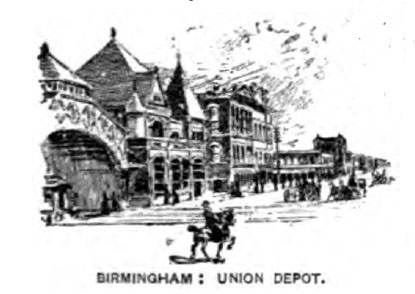
BIRMINGHAM: UNION DEPOT.
and the probate
courts. There are United States District Courts at
Birmingham, Montgomery and Mobile. The Capitol, at
Montgomery, is a substantial building with a many-columned
Grecian portico, and a high dome. It stands on Capitol
Hill, at the head of Dexter Avenue, and dates from 1849.
Here the Confederate Government was organized, Feb. 6, 1861,
and the Confederate Congress held its earlier sessions.
The Alabama State Troops have shown great efficiency at
different times, when called out to support the civil
authorities. They are armed with Springfield
breech-loaders, the artillery including Gatlings, Napoleons
and three-inch rifles. The First Regiment has its
headquarters at Mobile; the Second, at Birmingham; and the
Third at Selma. There are four batteries and two
troops attached to the regiments. Mobile and
Montgomery have colored companies. The State Troops
hold regimental encampments, for a week in summer, and are
inspected by United States army officers.
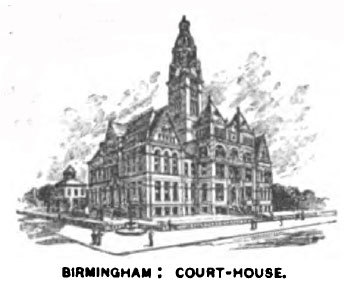
BIRMINGHAM: COURT HOUSE
Charities and Corrections - The Institution for the
Deaf and Dumb, at Talladega, was opened in 1860, and has 53
inmates (whites). The Alabama Academy for the Blind,
formerly united with the above-named, became independent in
1887. It has 30 pupils (whites). The State
Insane Asylum was opened at Tuskaloosa, in 1861, and has 340
inmates. The State Penitentiary at Wetumpka dates from
1841. The county convicts are farmed out to
contractors, and kept in private prisons and convict camps,
where they formerly suffered incalculably from cruel
punishments, vermin and sickness, until, in many cases,
death set them free. Recently, marked improvement has
been made in this system. The Rev. F. H. Wines
of Illinois pronounces Alabama's to be the best example of
the lease system in the Union. The majority of the
able-bodied convicts work in the mines near Birmingham.
The report of the State health officers for 1889 showed a
mortality of 20 per cent. in the Coalburg prison camp.
Alabama has 1,500 insane persons, 2,200 idiots, 1,400 blind,
700 deaf-mutes, 700 paupers, and 1,400 prisoners.
National Institutions - The Mount-Vernon Barracks
occupy a high plateau 28 north of Mobile, with their massive
buildings amid oak and magnolia groves, surrounded by heavy
brick walls. This is one of the handsomest posts of
the army; and dates from 1829, when Andrew Jackson
ordered an arsenal to be established here, on the site of
one of his favorite camp-grounds. In 1873 it was
transformed into a barrack, now occupied by part of the 4th
United States Artillery. In 1889-91 Geronimo, Nana,
Loco, and 380 other Arizona Apaches, prisoners of war, were
quartered here, under active religious and educational
influences. The United States Marine Hospital is at
Mobile. Fort Morgan, 30 miles south of Mobile, was
founded in 1819, on the site of Fort Bowyer, and cost
$1,250,000. Fort Gaines is a pentagonal work on
Dauphin Island, three miles from Fort Morgan, across the
channel. Neither
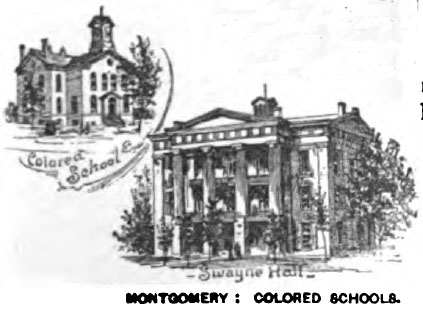
MONTGOMERY: COLORED SCHOOLS
[Page 34]
of these works is garrisoned. The lighthouses are on
Sand Island, Mobile Point (Fort Morgan), Dog-River Bar,
Choctaw Pass and Battery Gladden.
Education, in its higher forms, began with Greene
Academy, at Huntsville, in 1812. A good public-school
system was inaugurated in 1854, but the war and
reconstruction crippled it seriously. The normal
schools have all been founded since 1892, and contain 1,200
students. The normal schools for whites are at
Florence, Jacksonville, Livingston and Troy. In 1880,
Alabama, out of a population of 1,262,505, had 433,477
persons above the age of ten who could not write. This
appalling army of illiterates is mainly composed of negroes
and rustics; and the local educators are making earnest
efforts to secure more and better means to reduce the
prevailing ignorance. Alabama has a school population
of 485,551, with an average daily attendance of 162,516.
The school age is from 7 to 21; the average duration of the
school year, 155 days in the cities, and 70 days in the
country; the yearly expense, $750,000. The Teachers'
Reading Circle, the Colored Teachers' Association, the State
Teachers' Association (white), the Congressional (District)
Teachers' Institutes, and other active agencies are
achieving a good work in raising the educational standard.
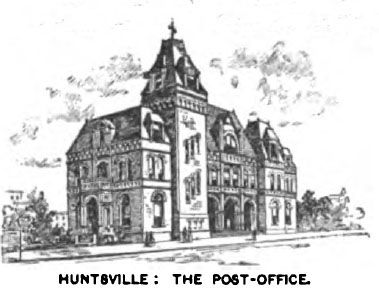
HUNTSVILLE: THE POST OFFICE
The University of Alabama occupies an estate of 500 acres,
at Tuskaloosa, with 18 professors and 240 students. It
was opened in 1831, and has an endowment of $300,000 from
lands granted by Congress in 1802, and held in trust by the
State, which pays eight percent. a year. The National
troops burned the building, in 1865; and there are now four
new edifices, enclosing a quadrangle, with Clark Hall,
containing the great hall and the library (of 9,000
volumes). The three courses are classical, scientific,
and civil engineering, with a law department containing 19
pupils. Military training is a prominent feature.
The State Agricultural and Mechanical College, at Auburn, in
the Cereal Belt, arose in 1872, as one of the National
land-grant schools of science; and has 12 instructors and
250 pupils. The Southern University, at Greensboro,
pertains to the M. E. Church South, and has 12 instructors
and 220 students. Before the war it was a rich
institution, and it is now slowly regaining its former
dignity. Howard College is a Baptist institution,
founded in 1842, at Marion, and since 1887 located at East
Lake, five miles from Birmingham, in the Ruhama Valley.
Spring-Hill College is a Catholic institution near Mobile,
opened in 1830, and with 100 students. The Medical
College of Alabama was founded in 1859, at Mobile, and has
12 instructors and 100 students. There are 35
academies, with 6,000 students, including the colleges for
women at Anniston, Tuskaloosa, Tuskegee, Huntsville,
Tuscumbia, Athens, Eufaula, Florence and Talladega.
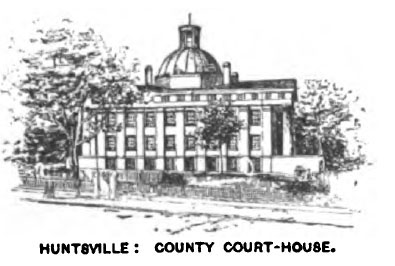
HUNTSVILLE: COUNTY COURT-HOUSE
The
colored people of Alabama have four normal schools, those at
Huntsville and Mobile being older than the white normal
schools. The State Normal and Industrial School was
founded in 1881, as an outgrowth of the Hampton (Va.)
school, and has been very successfully conducted by
Booker T. Washington, an eminent colored educator.
Its corn-fields, orchards, workshops and buildings occupy an
old plantation near the patrician town of Tuskegee, in the
Black Belt. The State makes a yearly appropriation,
paying part of the expenses of this school, which has 600
earnest and industrious students. Talladega College
was founded by the American Missionary Association in 1867,
and has several buildings, and large tracts of farm-lands.
There are 427 colored students, none of them collegiate.
The theological school for Congregational ministers is at
Talladega; that for Baptists is at Selma University; and the
Presbyterian conduct an institute for training colored
ministers, at Tuskaloosa.
[Page 35]
BIRMINGHAM: SLOSS IRON AND STEEL CO.
The State has 3,000 Sunday schools, with 20,000 teachers
and 160,000 pupils. The religious proclivities of the
people incline toward the Methodist and Baptist sects, the
first having above 200,000 members, and the second 175,000.
There are 12,000 Presbyterians, and 4,000 Episcopalians.
Newspapers came to Alabama in 1812, when Pasham
started the Madison Gazette at Huntsville. St.
Stephens followed with The Halcyon, in 1814; Mobile
with The Gazette, in 1816; and Tuskaloosa with The
Republican, in 1818. The Florence Gazette,
Montgomery Republican and Claiborne Clarion
appeared in 1820. Alabama now has 169 newspapers (15
daily, 144 weekly, and 8 monthly), with an average
circulation of 681 copies. Prominent among these are
the Mobile Register (founded in 1820), Montgomery
Advertiser (1828), Selma Times-Mail (1825), and
Birmingham Age-Herald.
The Chief Cities of Alabama (except Mobile) are
modern, and some of them have risen with marvelous rapidity
in the last 15 years. Mobile, successively French,
English, Span
BIRMINGHAM: BLOSS IRON & STEEL CO.
ANNISTON:
ST. MICHAEL'S AND ALL ANGELS.
[Page 36]
BIRMINGHAM: JOSIAH MORRIS BLOCK
ANNISTON:
THE ANNISTON INN.
ANNISTON:
NOBLE INSTITUTE FOR BOYS
[Page 37]
ANNISTON:
GRACE CHURCH
NOBLE
INSTITUTE FOR GIRLS
THE SCHOOL
AND DORMITORY
DECATUR:
THE MANUFACTURING QUARTER
[Page 38]
TUSKALOOSA:
UNIVERSITY OF ALABAMA
BESSEMER:
OFFICE OF THE BESSEMER LAND AND IMPROVEMENT CO.
BESSEMER:
DE BARDELEBEN COAL AND IRON COMPANY
[Page 39]
BESSEMER:
THE CHARLESTON BLOCK
BESSEMER:
DEBARDELEBEN COAL AND IRON CO.
SHEFFIELD:
THE SHEFFIELD HOTEL
[Page 40]
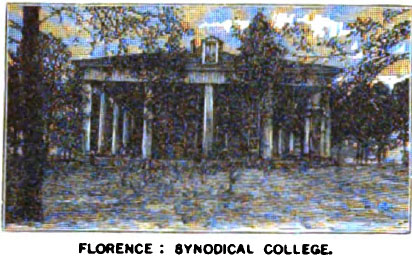
FLORENCE: SYNODICAL COLLEGE.
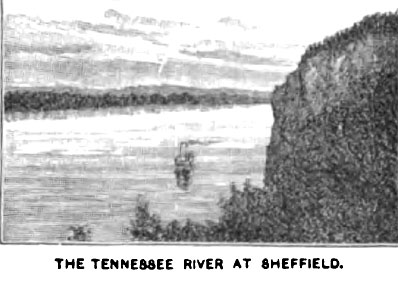
THE TENNESSEE RIVER AT SHEFFIELD
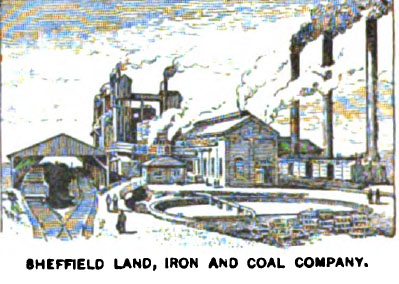
SHEFFIELD LAND, IRON AND COAL COMPANY

SHEFFIELD LAND, IRON AND COAL CO.'S OFFICE
[Page 41]
dega, Stevenson, Attalla,
Gadsden and other new municipalities, are fast coming into
public view.

THE TENNESSEE RIVER AT SHEFFIELD.
[Page 42]
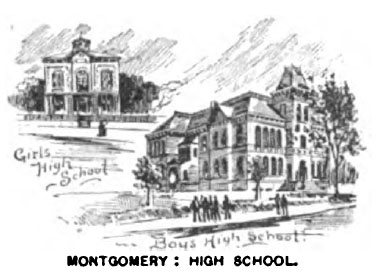
MONTGOMERY: HIGH SCHOOL
within the past decade,
especially in iron and steel and the connected industries.
The largest cotton-mills are at Tallassee, 35 miles from
Montgomery, at the great falls of the Tallapoosa, where 500
operatives are kept at work, in commodious stone factories.
The works were started in 1845, and the present mill dates
from 1854, having been built at a cost of $400,000.
During the Secession War, fire -arms were made here, but now
the products are sheetings, shirtings, duck, and cotton rope
and yarn.
The Finances of Alabama show an estimated valuation
of $378,000,000, with a State bonded debt of $9,240,000
(besides $250,000 unfunded), and county and municipal debts
of about $5,000,000. The yearly State, county, and
municipal taxes are above $2,000,000 yearly. The first
bank was founded at Huntsville in 1816. There are now
21 National banks, with about $3,500,000 capital; and six
savings-banks, with deposits of $1,300,000. There are
also seven State banks with a capital of $700,000.
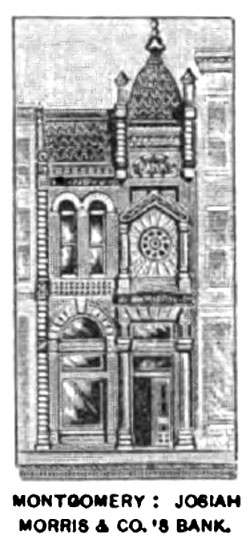
MONTGOMERY: JOSIAH
MORRIS & CO.'S BANK.
The
banking-house of Josiah Morris & Co. is the
pre-eminent private financial institution in Alabama, and
exercises an important and progressive influence in
Montgomery, the capital of the State, as well as in the
great mineral regions of Central and Northern Alabama.
Josiah Morris originated on the Eastern Shore of
Maryland, in 1818, and, after a number of years of active
business in Georgia and Louisiana, in 1851 he settled at
Montgomery, where his close attention to business and his
keen insight have been the corner-stones of a wonderfully
successful career. The firm has helped the great
railroad enterprises of this section with counsel and
credit; and especially has contributed largely to the
building of the South and North line, and the consequent
development of Birmingham. The large and increasing
business of this house has compelled the erection of a new
banking building, which is an ornament to the capital of
Alabama. Mr. Morris's associate is F. M.
Billing. Josiah Morris & Co. carry on a
general banking business.
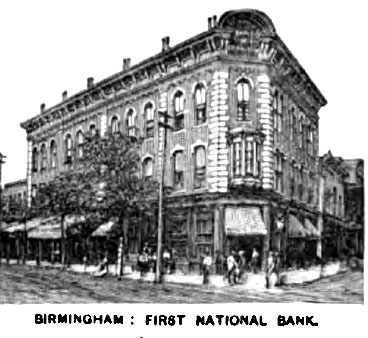
BIRMINGHAM: FIRST NATIONAL BANK
The
First National Bank of Birmingham, although established
within a very few years, now occupies a proud position among
the financial institutions of the South, and has the largest
deposits and does the largest business of any bank in the
State of Alabama. With a paid-in capital of $250,000,
this corporation already ahs a surplus exceeding $200,000;
and its first class fund. The efficient aid of such a
powerful financial institution as this has been wisely
exerted to advance the prosperity of Birmingham in many
ways, and to build up and sustain the great industries which
have risen here. At once conservative and
enterprising, the First National has continually developed
its opportunities and resources, with an unwavering faith in
the iron wealth of the Alabama hills as the true foundation
for a powerful monetary institution; and the result has
amply justified the sagacity of the undertaking. Its
building was the first three-story brick structure in
Birmingham, erected for this bank in 1872, by Charles
Linn, in an old corn-field, and then known all over
Alabama as "Linn's Folly." The First National was
organized in 1884, by the consolidation of the National Bank
of Birmingham and the City Bank. Then there were two
banks in the city, where there are now twelve.
|
![]()
![]()